| 154P London, UK Pharmacology 2016 |
Investigating the roles of kappa opioid receptors in neurochemical changes caused by stress and drugs of abuse
Introduction: Kappa opioid receptors (KOPrs) are involved in both stress responses and addiction-related behaviour (1). We are using an immunohistochemical approach to investigate brain regions that are activated by stress and drugs of abuse, and to distinguish the role of KOPrs in these responses. Expression of the immediate early gene c-Fos is a neuronal marker of recent neural activity. We are using c-Fos-GFP transgenic mice, in which expression of green fluorescent protein (GFP) is driven by the activation of c-Fos (2). This should provide an index of brain regions activated in these mice following an acutely stressful event or drug administration. Initial proof of concept have investigated the expression of cFos and cFos-driven GFP in multiple brain regions after a single injection of KOPr agonist.
Methods: Adult- (8-10wks) male cFos-GFP transgenic mice were injected (i.p) with saline or KOPr agonist U50,488 (20mg/kg). Two hours later, mice underwent transcardial perfusion fixation (under terminal pentobarbital anaesthesia) and brains were removed. Brain sections (40μm) were immunolabelled to assess cFos and cFos-driven GFP expression and quantified by fluorescence microscopy.
Results: A single injection of U50,488 significantly increased the expression of both cFos and GFP in nucleus accumbens (NAcc) and prelimbic area of the prefrontal cortex (PFC), compared to saline treated controls. In the CA1 region of the dorsal hippocampus (CA1), cFos, but not GFP, expression was significantly increased. No changes were seen in the dentate gyrus of the dorsal hippocampus (DG) (Table 1). All data mean ± S.E.M (N=6 per treatment) relative fluorescence intensity, corrected for background. Unpaired t-test *=P<0.05, ***=P<0.001.
Conclusion: These findings suggest that KOPr activation induces cFos expression in the nucleus accumbens and prelimbic area of the prefrontal cortex, both components of the ‘reward’ circuitry. The finding that in the CA1 region of the hippocampus cFos expression, but not cFos-driven GFP expression, was increased by U50,488 could reflect the temporal sequence, with downstream GFP expression occurring after cFos expression. We are currently investigating how the effects of acute KOPr agonist activation correlate with responses to behavioural stress.
References: 1. Bruchas MR et al. (2010) Brain Res 1314:44-55.2. Barth AL et al. (2004) J Neurosci 24:6466-75.


